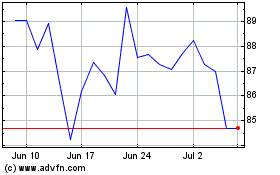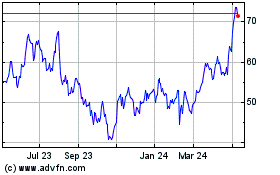MTA Rebukes Contractors Over Railroad Project Delays
February 25 2019 - 5:13PM
Dow Jones News
By Paul Berger
Metropolitan Transportation Authority board members on Monday
scolded contractors over significant delays to the installation of
a safety system across the authority's commuter rail lines, placing
it at risk of missing a federally mandated deadline.
"Your reputation as viable, aggressive, competent and willing
partners in work depends on what you do here," board member Charles
Moerdler told the officials during the meeting at the MTA's
headquarters in lower Manhattan
The companies, Bombardier Inc. and Siemens AG, were awarded a
joint contract totaling $428 million in 2013 to install the system
on the Long Island Rail Road and the Metro-North Railroad, two of
the busiest in the U.S.
The projects have suffered a series of setbacks because of
understaffing by the contractors as well as software and hardware
failures. Those failures include the recall of antennas that were
installed on more than 1,000 rail cars and that were later found to
be defective.
"It was a novice error and we did not believe we had hired
novices," MTA board member Susan Metzger said.
Paul Eliea, the program director for rail-automation projects at
Siemens Mobility, a division of Siemens AG, said that at least one
employee was fired over the antenna issue. "We are sorry for it and
have taken the correct steps to address it," Mr. Eliea said.
Congress mandated the installation of the safety system across
passenger and freight railroads in 2008 following several fatal
train crashes. The system uses equipment on board trains and
alongside tracks to monitor and automatically slow or stop a train
that is speeding or that has entered the wrong stretch of
track.
Initially, the nation's railroads were supposed to install the
system by the end of 2015. When it became clear that most railroads
couldn't meet that deadline, it was pushed to 2018 and railroads
were given the ability to seek an extension through the end of 2020
as long as they met certain requirements.
Many railroads struggled to meet the 2018 deadline because of
delays buying and installing equipment or complications that arose
from designing customized software that is interoperable with other
railroads that share the same tracks.
As of the end of 2018, only four of 41 railroads required to
install the system had completed the work, according to the Federal
Railroad Administration.
Deborah Chin, an MTA official who oversees the safety system's
implementation, told board members that the LIRR and Metro-North
are on course to meet the 2020 deadline. But Ms. Chin said they
lack confidence in Bombardier and Siemens because of the companies'
previous struggles with hardware and software issues.
Board members, some of whom have been at the MTA for more than a
decade, said this was the first time they could recall asking
contractors to address their committee. Neal Zuckerman, who led the
charge for the officials to attend, asked for an assurance that the
companies would meet the 2020 deadline.
Ronald Birkelbach, head of the signaling division of Bombardier
for the Americas, said the projects had proven more complicated
than the contractors anticipated. But he said that they have hired
more workers and are confident that the deadline will be met.
Write to Paul Berger at Paul.Berger@wsj.com
(END) Dow Jones Newswires
February 25, 2019 16:58 ET (21:58 GMT)
Copyright (c) 2019 Dow Jones & Company, Inc.
Bombardier (TSX:BBD.B)
Historical Stock Chart
From Mar 2024 to Apr 2024

Bombardier (TSX:BBD.B)
Historical Stock Chart
From Apr 2023 to Apr 2024
